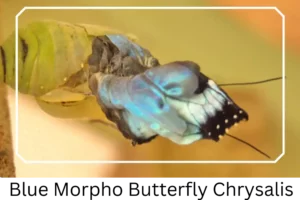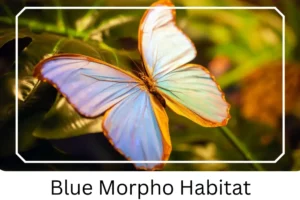Blue Morpho (Morpho menelaus)
The Blue Morpho butterfly, a jewel of Latin America, captivates enthusiasts and scientists alike with its dazzling blue wings and mysterious life cycle. This species not only plays a pivotal role in the biodiversity of tropical forests but also offers fascinating insights into the mechanisms of coloration and survival strategies in the insect world. Their striking appearance and intriguing behaviors make them a subject of admiration and study across the globe.
Scientific Classification
- Family: Nymphalidae
- Genus: Morpho
- Common names: Menelaus Blue Morpho
- Scientific Name: Morpho menelaus
Overview
Renowned for their brilliant blue wings, Blue Morphos are a symbol of the rich tapestry of life found within the dense foliage of Central and South American rainforests. These butterflies have intrigued not only 20th-century collectors but also modern scientists who delve into their unique biological makeup. The iridescent blue that adorns their wings is not just a marvel of nature’s artistry but also a complex adaptation that has evolved over millennia.
Description and Identification
Caterpillar
The journey of a Blue Morpho begins in its larval stage, where the caterpillar sports a red-brown hue interspersed with vibrant green spots. Covered in protective bristles, these caterpillars can release irritants to deter predators, a testament to the evolutionary arms race that has shaped their existence. Their eggs are strategically laid to ensure immediate access to food upon hatching.
Pupa

Transitioning into the pupa stage, the Blue Morpho’s chrysalis mimics the color and shape of a small conch shell, a bright green beacon among the foliage. This camouflage safeguards the butterfly during its most vulnerable period, showcasing nature’s ingenuity in protection and survival.
Adult Butterfly
Upon reaching adulthood, the Blue Morpho reveals its true splendor. The males, especially, flaunt an iridescent blue on their wings, bordered by stark black. This coloration, a result of complex microstructures, serves multiple purposes from attracting mates to warding off predators. Despite their vibrant topside, the underside of their wings tells a different story, with a mottled brown pattern featuring eyespots designed to confuse threats.
Sexual Dimorphism: Not immediately apparent to the untrained eye, the males boast a slightly brighter hue than their female counterparts, a subtle distinction that plays a crucial role in their mating rituals.
Color and Appearance: The play of light on their wings creates a mesmerizing blue that varies in intensity and hue, edged with a definitive black border. The underside presents a stark contrast, designed to blend with the forest floor.

 Average Wingspan: The wingspan of an adult Blue Morpho can reach up to 12 cm (4.72 in), a size that facilitates their distinctive slow and floppy flight pattern.
Average Wingspan: The wingspan of an adult Blue Morpho can reach up to 12 cm (4.72 in), a size that facilitates their distinctive slow and floppy flight pattern.
Flight Pattern: Their flight is as unique as their color, a gentle and seemingly unhurried flutter that belies the efficiency and purpose of each movement.

Blue Morpho Butterfly Eggs
Eggs
Embarking on life’s journey, the eggs of the Blue Morpho are diminutive yet remarkable. Shaped like dewdrops, these pale green orbs are carefully placed on the underside of leaves, awaiting the next generation of caterpillars.
Quick Facts | |
| Distribution | From Mexico to Central and South America, including unique ecosystems like the Cerrado and Venezuela. |
| Habitat | Predominantly found at the forest floor and lower vegetation layers within tropical forests. |
| Weight | A lightweight species, adults typically weigh between 2-3 grams. |
| Predators | Birds constitute their main threat, alongside other forest inhabitants. |
| Lifespan of Adults | Approximately 115 days, a brief yet vibrant existence. |
| Host Plants | They favor flowers from Erythroxylum, Dalbergia, and Fabaceae species for laying eggs. |
| Adult Diet | Primarily flower nectar and ripe fruits, a testament to their role in pollination. |
How to Identify Blue Morpho?
Identifying a Blue Morpho butterfly is a thrilling experience, often marked by the sudden flash of blue as they flutter by. When their wings are closed, their brown underside with eye-catching eyespots helps them blend into the forest backdrop, making them a bit elusive. To spot these magnificent creatures, look for their unique flight pattern in clearings and along riverbanks within tropical forests. Their iridescent blue wings are most visible when the sun filters through the canopy, illuminating them against the green backdrop. Observing these butterflies requires patience and a keen eye, especially during the early morning or late afternoon when they are most active.
Did You Know?
- The Blue Morpho’s wings are a marvel of natural engineering. Unlike other butterflies that owe their color to pigments, the Blue Morpho’s coloration comes from the microscopic structure of their wing scales, which reflect and refract light to produce the vivid blue we see.
- Unlike many other butterfly species, Blue Morpho caterpillars exhibit social behaviors, often found feeding in groups. This communal lifestyle offers protection in numbers and increases their chances of survival against predators.
Conclusion
The Blue Morpho butterfly remains one of nature’s most splendid creations, embodying the mystery and beauty of the tropical rainforests. Their life cycle, from the camouflaged caterpillar to the dazzling adult, illustrates the complexity and interconnectedness of ecosystems. By understanding and appreciating these magnificent creatures, we can foster a deeper respect for the natural world and the delicate balance that sustains it.
Blue Morpho Pictures

Scientific Classification

- Family: Nymphalidae
- Genus: Morpho
- Common names: Menelaus Blue Morpho
- Scientific Name: Morpho menelaus






